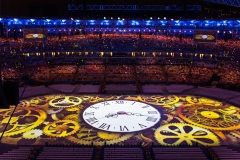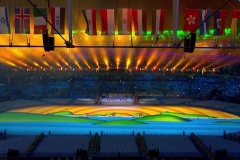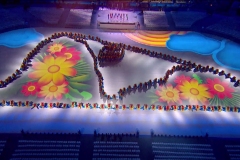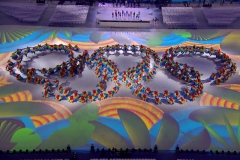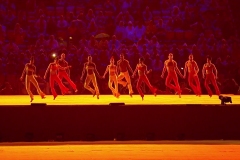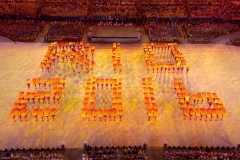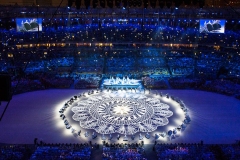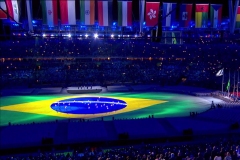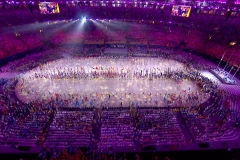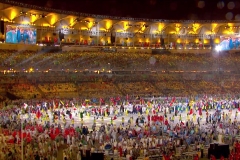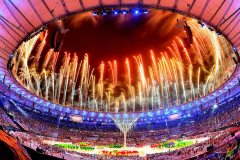Life imitates art here as the Closing Ceremony is always the poor boy in terms of time, as the Opening Ceremony eats into all that is available, and this presentation is no exception. We had a new creative team headed by Queen of Carnival Rosa Magalhaes and choreographed by choreo chart superstar Bryn Walter.
Box City was history and indeed the whole of the Opening Ceremony scenery, field of play cover and lighting and sound had been removed during the transformation back to a soccer stadium and the turfing of the pitch for the soccer finals. The athletes were to be seated around the field of play and we had a new performance and protocol stage.
Even the cauldron had been moved to the other end of the stadium and in the change over Nicola and the guys from Agora re rigged to my Closing Ceremony lighting rig design which became 360 degrees after the removal of the massive Box City set at the South End of the stadium.
The Closing Ceremony was an exercise in forward planning, skill and a lot of good fortune as to light it we had no performers, no set, no rehearsals in what was now a soccer venue and indeed not even a stage! As for the Opening we had to combine light and projection and focus accurately onto the performers but with absolutely no rehearsal or focus session with any cast, how did we do this?
The real heroes were Master mass choreographers Bryn Walters and Claire Terri and their team who produced extremely accurate choreo charts exactly mirroring that with which they rehearsed with the performers in the adjacent marked out car park. Once the evenings game had finished our technical team, captained by James Lee and having negotiated permission to actually walk on the grass, covered the pitch with four large sheets of parachute silk.
We then projected the choreo charts onto this surface at exactly the right scale and then focused our lights onto the accurate positions marked on the projected chart for each scene., the lighting and projection for both the Ceremonies were applauded for their seamless integration.
Each of our three lighting desks had their own WYSIWYG system and this allowed the guys to work when certain elements of our rig were not yet turned on or being maintained, or on several occasions had been switched off because we had run out of diesel for the generators. Actually we had the diesel but not the means to get it from the bowsers on the other side of Rio!
There is no doubt in my mind, that along with parachute silk and English Breakfast tea, without WYSIWYG we would not have come anywhere close to the standard of lighting that we achieved in the Closing Ceremony.
Lighting Designer: Durham Marenghi
Lighting Team Manager: Jennie Marenghi
Associate LD: Joyce Drummond
TV Lighting Director: Nick Collier
Lead Lighting Programmer: Andy Voller
Lighting Programmer: Ross Williams
Lighting Programmer: Paulinho Lebrão
Follow spot Captain: Chris Henry
Photos courtesy of Cerimônias Cariocas
